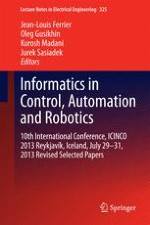The present book includes a set of selected papers from the tenth “International Conference on Informatics in Control Automation and Robotics” (ICINCO 2013), held in Reykjavík, Iceland, from 29 to 31 July 2013. The conference was organized in four simultaneous tracks: “Intelligent Control Systems and Optimization”, “Robotics and Automation”, “Signal Processing, Sensors, Systems Modeling and Control” and “Industrial Engineering, Production and Management”. The book is based on the same structure.
ICINCO 2013 received 255 paper submissions from 50 countries, in all continents. After a double blind paper review performed by the Program Committee only 30% were published and presented orally. A further refinement was made after the conference, based also on the assessment of presentation quality, so that this book includes the extended and revised versions of the very best papers of ICINCO 2013.
